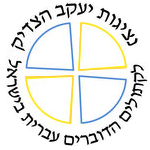Seder at the Parish during the Shoah
Irena Steinfeldt, Director of the Righteous among the Nations Department at Yad Vashem in Jerusalem, published a short article on Catholic clergy who saved Jews during the Shoah in the July 2009 edition of Yad Vashem Jerusalem Quarterly Magazine (vol. 54), 15. With her permission we reproduce the article here.
While walking to the Hall of Rememberance during his visit to Yad VaShem, Pope Benedict XVI passed by the tree planted in honor of the Celis family from Belgium: two brothers - Father Hubert and Father Louis Celis, who were Catholic priests - their father and siblings.
During the Holocaust the Celis family hid the four Rotenberg children, whose parents had been deported to Auschwitz in November 1942.

Fathers Hubert and Louis Celis with their father Joseph
To camouflage their identity, the Rotenbergs had to attend church services, but in the privacy of his home, Father Louis Celis made sure that they preserved their Jewish identity, that Wolfgang put on his tefilin (phylacteries) and recited his prayers. After the war, Father Hubert Celis wrote: "I never tried to convert the Rotenberg children to the Catholic faith. I always respected their religious beliefs. Besides, Mrs. Rotenberg had confidence in me and I had given her my word as a priest."
Hundreds of clerics of all Christian denominations have been recognized over the years as Righteous among the Nations, among them many Catholics. Hubert and Louis Celis received the title of Righteous for their role in the rescue of the four Rotenberg siblings, but their conduct is especially admirable because of the deep respect they showed for the children's religion. Like them, Don Gaetano Tantalo of Tagliacozzo Alto, Italy not only hid seven members of the Orvieto and Pacifici families, but also went out of his way to enable them to perform Jewish rituals. The page on which he did his calculation to determine the date of Passover is exhibited in Yad VaShem's Holocaust History Museum, with the fascinating story of the celebration of the Jewish seder at the home of a parish priest during the German occupation of Italy in 1944.
The attitude of the churches towards rescuing Jews during the Shoah touches upon intricate and often painful questions, and when examining the particulars of every case, the Commission for the Designation of the Righteous is often faced with enormous challenges that reflect the complexity of the topic: the baptizing of children (was it motivated by the theological mission to the convert the Jews and save their souls or was the purpose to protect them and hide their Jewish identity?); the return of the children to the Jewish fold at the end of the war, what made rescue more current in certain dioceses or religious orders that others, and to what extent did clerics act as individuals or make their decisions as a result of instruction and guidance from their superiors?
Christian conduct during the Holocaust continues to challenge the Christian world well into the 21st century. A range of factors played a role in influencing the behavior of church leaders and clerics when confronted with the murder of the Jews. Like other groups, many remained silent and a number of clerics went as far as to collaborate but there were those who risked their lives to rescue Jews. While Christian anti-Jewish theology and its teaching of contempt contributed to indifference and collaboration, other clerics and Christians saw it as their religious duty to intervene and act.
Listen to the testimony of Sigmund Rotenberg












 Memorial to the Jesuit Righteous Among the Nations
Memorial to the Jesuit Righteous Among the Nations